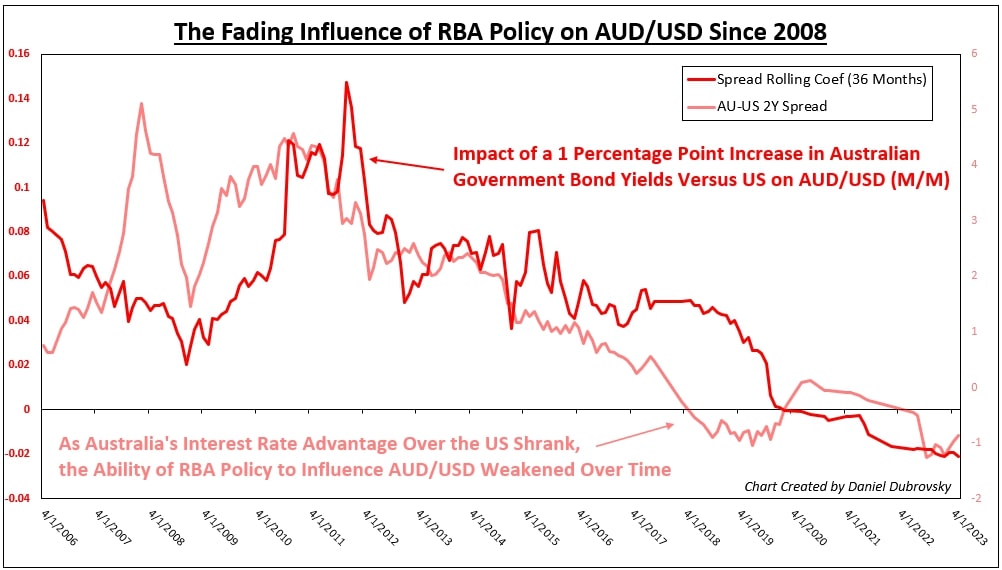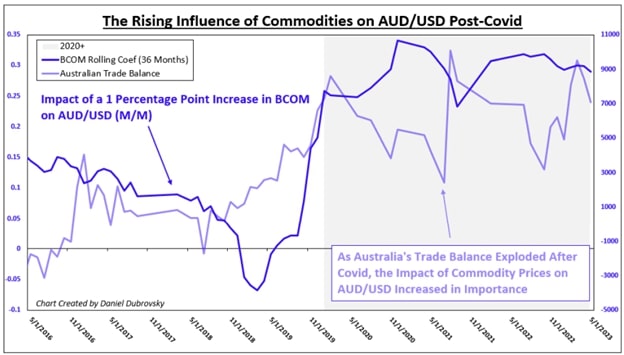The Australian Dollar (AUD) is a currency influenced by various factors that shape its direction against the US Dollar (USD). To comprehend the fundamental bias of the AUD/USD exchange rate, it is crucial to analyze the interplay between monetary policy, market sentiment, and commodity prices. These key variables have undergone significant shifts over time, impacting the behavior of the Australian Dollar.
Understanding the Importance of Monetary Policy, Market Sentiment, and Commodity Prices for the Australian Dollar
How Has RBA & Fed Policy Divergence Been Influencing AUD/USD

One vital aspect that influences AUD/USD is monetary policy, particularly the divergence between the Reserve Bank of Australia (RBA) and the Federal Reserve (Fed). Historically, the RBA vs. Fed policy was considered a reliable predictor of AUD/USD direction. However, in recent years, this relationship has become a poorer predictor, indicating changing dynamics in the market.
How Has Emerging Market Sentiment Been Impacting AUD/USD
Another critical factor impacting the AUD/USD exchange rate is financial market sentiment. As Australia sits at the front end of the global supply chain, the country’s currency is influenced by stock markets, especially those related to Emerging Markets. Understanding and analyzing market sentiment is crucial to predicting the direction of the Australian Dollar.
Impact of Emerging Market Sentiment

While RBA policy became an increasingly poorer predictor of AUD/USD, Emerging Market sentiment became more important. The dark green line on the chart below is the rolling EEM coefficient. When this line is rising above 0, a 1 percentage point boost in monthly Emerging Market performance shows increasingly better returns in AUD/USD (m/m), controlling for bond yield spreads and commodity prices.
As major central banks injected liquidity into the financial system after the 2008 recession, sentiment became an increasingly better predictor of the Aussie exchange rate. However, the dark green line peaked just before Covid and stayed lower thereafter, indicating a potential decrease in the influence of market sentiment in the post-Covid era.
Impact of Commodity Prices and Post-Covid Performance

China plays a significant role as Australia’s largest trading partner, with commodities being a vital driver of the Australian Dollar. The dark blue line on the chart below is the rolling BCOM coefficient, zoomed in on just the post-2016 period. When this line is rising increasingly above 0, a 1 percentage point boost in the BCOM Index tends to elicit a stronger positive effect on AUD/USD (m/m), controlling for bond yield spreads and market sentiment.

Notably, the dark blue line surged higher heading into Covid and remained elevated thereafter. This is attributed to the surge in Australia’s trade balance during the pandemic, as the value of the nation’s exports significantly surpassed its imports. Commodity prices played a crucial role, and AUD/USD paid more attention to the BCOM Index rather than market sentiment and bond yield spreads.
Analyzing the post-Covid period, it becomes evident that commodities became a more important factor than Emerging Market sentiment for driving the AUD/USD exchange rate. This shift in emphasis can be attributed to the significant impact of global trading dynamics and surging commodity prices on Australia’s economy, subsequently influencing the exchange rate. Understanding these changing dynamics is crucial for market participants seeking to predict and navigate the movements of the Australian Dollar.
Click here to check the AUD/USD Live Rate Chart
Conclusion
In conclusion, while monetary policy is traditionally considered a key driver of exchange rates, it is essential to acknowledge that each currency behaves differently due to the unique traits of various economies. For the Australian Dollar, factors such as market sentiment and commodity prices significantly contribute to its fundamental bias. Over time, the influence of certain variables has changed, and adapting fundamental analysis to evolving economic environments becomes imperative.
The study presented here sheds light on the evolving nature of AUD/USD dynamics. RBA policy direction became an increasingly poorer predictor of the exchange rate following the 2008 financial crisis, while market sentiment and commodity prices assumed greater significance. However, it is important to acknowledge that this analysis utilized rolling regressions, and individual regressions may have their own limitations. Nonetheless, the study underscores the importance of ongoing analysis and adaptation to changing economic landscapes, allowing market participants to gain valuable insights into potential shifts in the AUD/USD exchange rate and make informed trading decisions.
Click here to read our latest article about US ‘Hard Landing’

